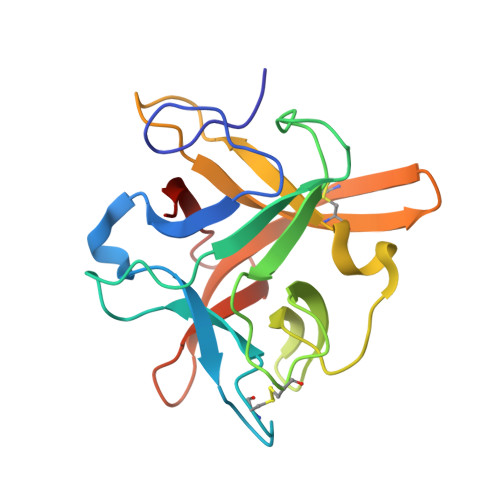A conserved tryptophan (W91) at the barrel-lid junction modulates the packing and stability of Kunitz (STI) family of inhibitors.
Majumder, S., Khamrui, S., Banerjee, R., Bhowmik, P., Sen, U.(2015) Biochim Biophys Acta 1854: 55-64
- PubMed: 25448016
- DOI: https://doi.org/10.1016/j.bbapap.2014.10.021
- Primary Citation of Related Structures:
4H9W, 4HA2, 4TLP - PubMed Abstract:
β-trefoil fold, consisting of a six stranded β-barrel capped at one end by a lid comprising of another six β-strands, is one of the most important folds among proteins. Important classes of proteins like Interleukins (ILs), Fibroblast Growth Factors (FGFs), Kunitz (STI) family of inhibitors etc. belong to this fold. Their core is packed by hydrophobic residues contributed by the 6 stranded β-barrel and three β-hairpins that make essential contacts with each other and keep the protein in 'topologically minimal frustrated state'. A complete database analysis of the core residues of the β-trefoil fold proteins presented here identified a conserved tryptophan (W91) residue in the Kunitz (STI) family of inhibitors that projects from the lid and interacts with the bottom layer residues of the barrel. This kind of interactions is unique in Kunitz (STI) family because no other families of β-trefoil fold have such a shear sized residue at the barrel lid junction; suggesting its possible importance in packing and stability. We took WCI as a representative of this family and prepared four cavity creating mutants W91F-WCI, W91M-WCI, W91I-WCI & W91A-WCI. CD experiments show that the secondary structure of the mutants remains indistinguishable with the wild type. Crystal structures of the mutants W91F-WCI, W91M-WCI & W91A-WCI also show the same feature. However, slight readjustments of the side chains around the site of mutation have been observed so as to minimize the cavity created due to mutation. Comparative stability of these mutants, estimated using heat denaturation CD spectroscopy, indicates that stability of the mutants inversely correlates with the size of the cavity inside the core. Interestingly, although we mutated at the core, mutants show varying susceptibility against tryptic digestion that grossly follow their instability determined by CD. Our findings suggest that the W91 residue plays an important role in determining the stability and packing of the core of WCI.
Organizational Affiliation:
Crystallography and Molecular Biology Division, Saha Institute of Nuclear Physics, 1/AF Bidhannagar, Kolkata 700064, India.














